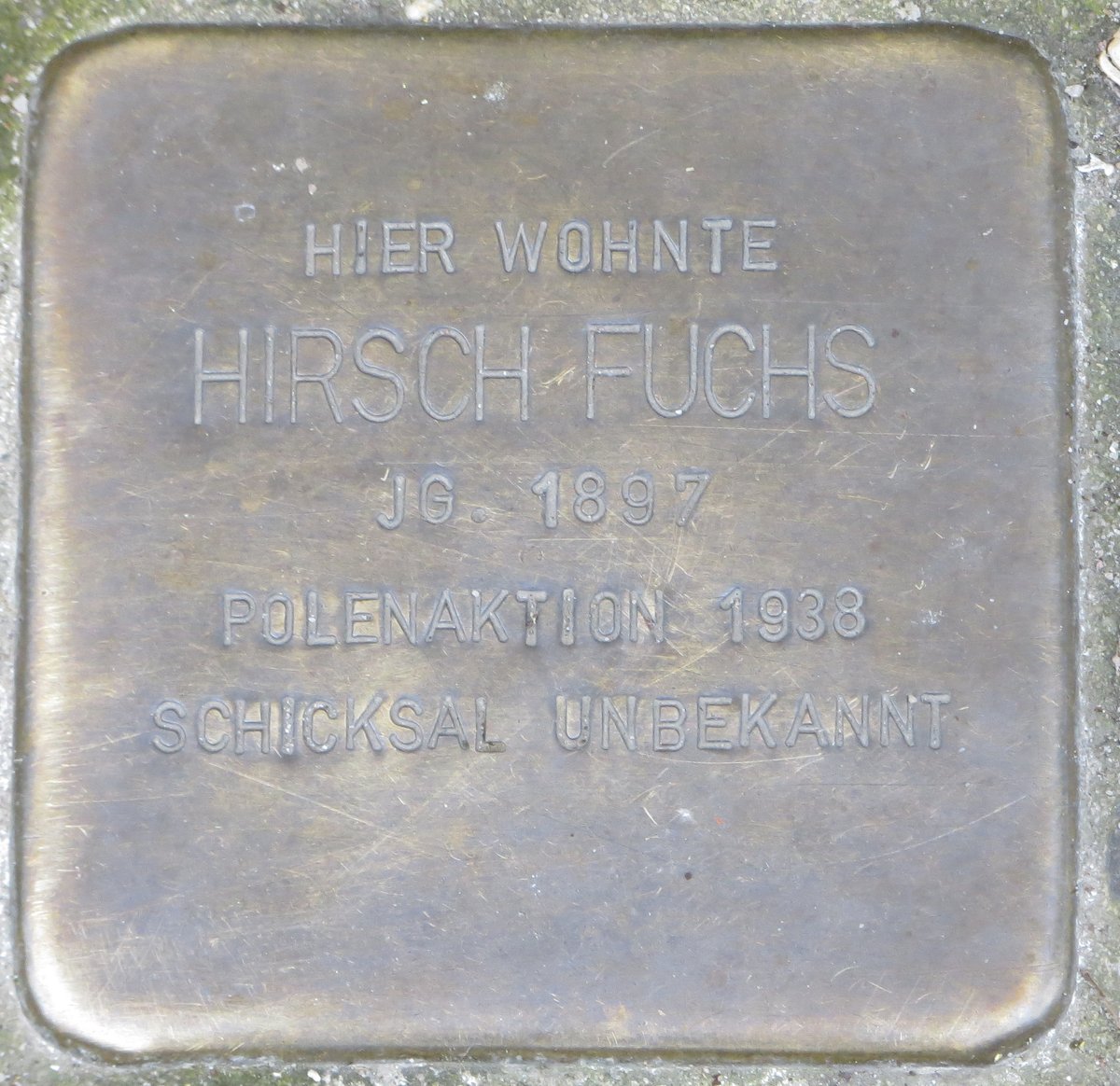
Visiting the Stolperstein Dedicated to Hirsch Fuchs in Karlsruhe, Germany: Visiting Hours, Tickets, and Historical Significance
Date: 14/06/2025
Introduction
The Stolperstein project, initiated in 1992 by artist Gunter Demnig, is a profound and decentralized form of Holocaust remembrance. Stolpersteine—“stumbling stones”—are small brass plaques embedded in sidewalks outside the last freely chosen residences or workplaces of individuals persecuted under the Nazi regime. In Karlsruhe, more than 300 such stones, including one dedicated to Hirsch Fuchs, integrate remembrance into the city’s daily life. This comprehensive guide explores the history and significance of the Hirsch Fuchs Stolperstein, practical information for visitors, and the broader cultural impact of these memorials (Stolpersteine Karlsruhe, Gedenkbuch Karlsruhe, Stolpersteine.eu).
What Are Stolpersteine? Origins and Symbolism
Historical Development
Conceived by Gunter Demnig, the Stolperstein project began as a way to memorialize victims of Nazi persecution at their last self-chosen addresses. Each stone is a 10-centimeter brass plaque, inscribed with the victim’s name, birthdate, and fate, beginning with “Hier wohnte…” (“Here lived…”). Stolpersteine serve as decentralized memorials, integrating remembrance into public space and everyday consciousness. By 2024, more than 100,000 Stolpersteine had been laid in over 1,800 cities across more than 30 countries (Stolpersteine.eu).
Symbolic Meaning
The term “stumbling stone” is metaphorical: passersby are invited to “stumble” upon the memory of the victims, pausing to reflect and honor their lives. The act of bowing to read a Stolperstein’s inscription is both a physical and symbolic gesture of remembrance.
Stolpersteine in Karlsruhe: Local Context
Karlsruhe, in Baden-Württemberg, has actively participated in the Stolperstein project. Over 300 stones commemorate Jews, Sinti and Roma, political prisoners, and other victims of Nazi persecution. These memorials are supported by local organizations, schools, and volunteers, fostering ongoing community engagement and education (Stolpersteine Karlsruhe, ka-news.de).
Nearby Historical Sites
Visiting the Stolpersteine can be combined with exploring Karlsruhe’s rich historical landscape, including the Karlsruhe Palace, the State Art Gallery, and the Jewish Museum Karlsruhe (CultureTourist.com, thecrazytourist.com).
The Hirsch Fuchs Stolperstein: Historical Background
Life and Legacy of Hirsch Fuchs
Hirsch Fuchs was born on December 1, 1824, in Weingarten and later became a master butcher and cattle dealer. In 1855, he married Fanny Ottenheimer, and together they had 15 children. Seeking better economic opportunities and education for his family, Fuchs moved from Weingarten to Karlsruhe in 1871, settling at Zähringerstraße 28 (Gedenkbuch Karlsruhe).
The Fuchs family integrated into Karlsruhe’s civic and Jewish community life. Three of Hirsch’s sons founded the successful timber trading company “H. Fuchs Söhne” (HFS), with branches in Stuttgart and Strasbourg. Despite their achievements, the rise of National Socialism in 1933 subjected the family to escalating persecution, mirroring the fate of countless Jewish families in Germany.
Location and Visiting Information
Where to Find the Hirsch Fuchs Stolperstein
- Address: Zähringerstraße 28, Karlsruhe, Germany (mapcarta.com)
- Public Transport: Easily accessible by tram or on foot from the city center.
- Nearby Attractions: Karlsruhe Palace, Natural History Museum, and other Stolpersteine.
Visiting Hours and Admission
- Hours: Open and accessible 24/7, year-round.
- Admission: Free; no tickets or booking necessary.
Accessibility
The Stolperstein is located on a public sidewalk and is generally accessible for visitors with mobility aids. The area is flat and suitable for wheelchairs and strollers.
Visitor Tips and Etiquette
- Visit in the morning or late afternoon for a quieter experience.
- Join a guided remembrance tour for deeper historical context (CultureTourist.com).
- Clean the Stolperstein gently with a soft cloth—a local tradition of respect.
- Avoid standing directly on the stone and take a moment to read the inscription.
Community Engagement and Maintenance
Local volunteers, schools, and organizations regularly maintain Stolpersteine, particularly around Holocaust Remembrance Day and other memorial dates (rk-karlsruhe.de). Community cleaning events and installation ceremonies foster ongoing remembrance and education.
Educational and Cultural Significance
Stolpersteine personalize Holocaust history by restoring names and stories to public consciousness. In Karlsruhe, they serve as educational tools, with schools and community groups engaging in research and commemorative activities (BNN.de). The decentralized nature of these memorials ensures that remembrance becomes part of everyday life.
Frequently Asked Questions (FAQ)
Q: Do I need a ticket to visit the Hirsch Fuchs Stolperstein?
A: No, the memorial is free and accessible at any time.
Q: How can I find Stolpersteine in Karlsruhe?
A: Use online maps, QR codes on some stones, or guides from the tourist information office (Denkmalprojekt.org).
Q: Are guided tours available?
A: Yes, local organizations sometimes offer guided remembrance tours; check with the tourist information center for details.
Q: Is the memorial accessible for visitors with disabilities?
A: Yes, Stolpersteine are embedded in public walkways and are generally accessible.
Enhancing Your Visit
- Use interactive maps and audio guides, such as those available via the Audiala app, to enrich your experience.
- Explore related sites like the Jewish Museum Karlsruhe and Karlsruhe Palace for broader historical context.
- Join community remembrance activities to engage more deeply.
Conclusion
The Stolperstein dedicated to Hirsch Fuchs at Zähringerstraße 28 stands as a tangible, personal reminder of Karlsruhe’s Jewish history and the tragic impact of Nazi persecution. By visiting and reflecting upon this memorial, you contribute to a culture of remembrance and ongoing education. The Stolpersteine’s integration into Karlsruhe’s daily life ensures that the stories of victims like Hirsch Fuchs remain present and meaningful for future generations. Enhance your visit with audio guides, participate in community events, and help keep memory alive (Stolpersteine Karlsruhe, PragueViews.com, ka-news.de).
References
- Stolpersteine Karlsruhe
- Gedenkbuch Karlsruhe
- Stolpersteine.eu
- ka-news.de
- BNN.de
- CultureTourist.com
- PragueViews.com
- Denkmalprojekt.org
- rk-karlsruhe.de
























































































































































































